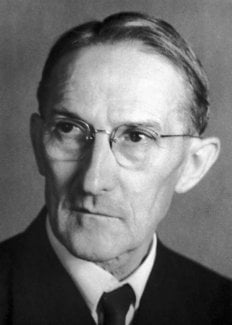Jaroslav Heyrovsky
Biographical

Jaroslav Heyrovsky was born in Prague on 20th December, 1890, the fifth child of Leopold Heyrovsky, Professor of Roman Law at the Czech University of Prague, and his wife Clara, née Hanl.
He obtained his early education at secondary school till 1909 when he began his study of chemistry, physics and mathematics at the Czech University, Prague. From 1910 to 1914 he continued his studies at University College, London, under Professors Sir William Ramsay, W.C.Mc.C. Lewis and F.G. Donnan, taking his B.Sc. degree in 1913. He was particularly interested in working with Professor Donnan, on electrochemistry.
During the First World War Heyrovsky did his war service in a military hospital as dispensing chemist and radiologist, which enabled him to continue his studies and to take his Ph.D. degree in Prague in 1918 and D.Sc. in London in 1921.
Heyrovsky started his university career as assistant to Professor B. Brauner in the Institute of Analytical Chemistry of the Charles University, Prague; he was promoted to Associate Professor in 1922 and in 1926 he became the first Professor of Physical Chemistry at this University.
Heyrovsky’s invention of the polarographic method dates from 1922 and he concentrated his whole further scientific activity on the development of this new branch of electrochemistry. He formed a school of Czech polarographers in the University, and was himself in the forefront of polarographic research.
In 1950 the Professor was appointed Director of the newly established Polarographic Institute which has been incorporated into the Czechoslovak Academy of Sciences since 1952.
Many universities and seats of learning have honoured Professor Heyrovsky. He was elected Fellow of University College, London, in 1927, and received honorary doctorates of the Technical University, Dresden, in 1955, the University of Warsaw in 1956, the University Aix-Marseille in 1959, and the University of Paris in 1960. He was granted honorary membership of the American Academy of Arts and Sciences, Boston, Mass., in 1933; of the Hungarian Academy of Sciences in 1955; the Indian Academy of Sciences, Bangalore, in 1955; the Polish Academy of Sciences, Warsaw, in 1962; was elected Corresponding Member of the German Academy of Sciences, Berlin, in 1955; member of the German Academy of Natural Scientists, Leopoldina (Halle-Saale) in 1956; Foreign Member of the Royal Danish Academy of Sciences, Copenhagen, in 1962; Vice-President of the International Union of Physics from 1951 to 1957; President and first honorary member of the Polarographic Society, London; honorary member of the Polarographic Society of Japan; honorary member of the Chemical Societies of Czechoslovakia, Austria, Poland, England and India.
In Czechoslovakia he was awarded the State Prize, First Grade, in 1951, and in 1955 the Order of the Czechoslovak Republic.
Heyrovsky has lectured on polarography in the United States of America in 1933, the USSR in 1934, England in 1946, Sweden in 1947, the People’s Republic of China in 1958, and in U.A.R. (Egypt) in 1960 and 1961.
In 1926 Professor Heyrovsky married Marie Koranová, and there are two children of the marriage, a daughter, Judith, and a son, Michael.
This autobiography/biography was written at the time of the award and first published in the book series Les Prix Nobel. It was later edited and republished in Nobel Lectures. To cite this document, always state the source as shown above.
Jaroslav Heyrovsky died on March 27, 1967.
Nobel Prizes and laureates
Six prizes were awarded for achievements that have conferred the greatest benefit to humankind. The 14 laureates' work and discoveries range from quantum tunnelling to promoting democratic rights.
See them all presented here.
